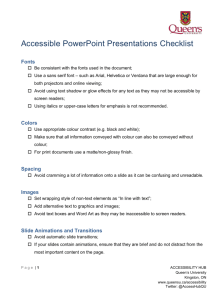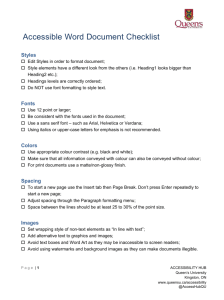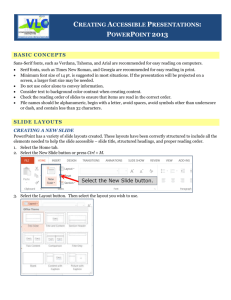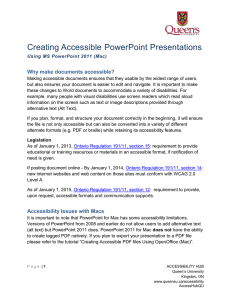Creating Accessible PowerPoint Presentations Why make documents accessible?
advertisement
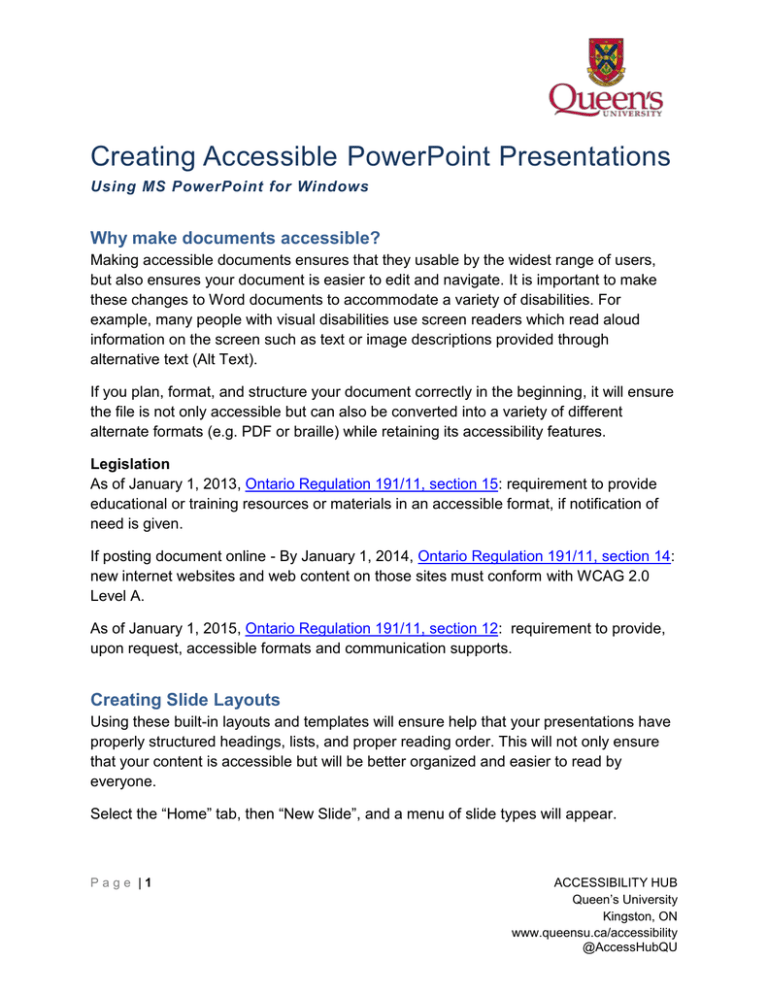
Creating Accessible PowerPoint Presentations Using MS PowerPoint for Windows Why make documents accessible? Making accessible documents ensures that they usable by the widest range of users, but also ensures your document is easier to edit and navigate. It is important to make these changes to Word documents to accommodate a variety of disabilities. For example, many people with visual disabilities use screen readers which read aloud information on the screen such as text or image descriptions provided through alternative text (Alt Text). If you plan, format, and structure your document correctly in the beginning, it will ensure the file is not only accessible but can also be converted into a variety of different alternate formats (e.g. PDF or braille) while retaining its accessibility features. Legislation As of January 1, 2013, Ontario Regulation 191/11, section 15: requirement to provide educational or training resources or materials in an accessible format, if notification of need is given. If posting document online - By January 1, 2014, Ontario Regulation 191/11, section 14: new internet websites and web content on those sites must conform with WCAG 2.0 Level A. As of January 1, 2015, Ontario Regulation 191/11, section 12: requirement to provide, upon request, accessible formats and communication supports. Creating Slide Layouts Using these built-in layouts and templates will ensure help that your presentations have properly structured headings, lists, and proper reading order. This will not only ensure that your content is accessible but will be better organized and easier to read by everyone. Select the “Home” tab, then “New Slide”, and a menu of slide types will appear. Page |1 ACCESSIBILITY HUB Queen’s University Kingston, ON www.queensu.ca/accessibility @AccessHubQU Appropriate Use of Colour When using colour, you must make sure that any information conveyed with colour is also conveyed in black and white. For example, if you’re using colour to identify key words in a document, make sure that you also make them stand out in another way (for example, by putting them in bold; italics are not recommended). Colour Contrast You must provide high colour contrast to the text in your document. A good example of high colour contrast is black and white; while an example of poor colour contrast is light yellow and white. Use of Fonts Use sans-serif fonts such as Arial, Helvetica or Verdana , that are large enough for both projectors and online viewing; Avoid inserting WordArt and Text-Boxes as they may not be accessible by screen readers; Avoid using text shadow or glow effects for any text as they may not be accessible by screen readers. Alternative Text Any pictures or graphs within a document must be given alternative text. Alternative text must give an accurate description of what the item is, so that the user’s assistive technology may convey what information is demonstrated by the item. When entering alternate text you will notice there is a Title and Description field. The Title field is used to enter text that when read to someone using a screen reader, it Page |2 ACCESSIBILITY HUB Queen’s University Kingston, ON www.queensu.ca/accessibility @AccessHubQU allows the user to decide whether to listen to the text provided by the Description. However, it is generally recommended that the main ALT text should be put into the Description field. PowerPoint 2013 1. Select the image and right click inside the image. A menu will appear. 2. Select “Format Picture. 3. In the Format Picture window, select the Size and Properties tab on the right and select “ALT TEXT”. 4. Then insert the ALT Text into the Description field, NOT the Title field. Click the Close icon. PowerPoint 2010 1. Select “Format Picture”, “Format Shape”, “Format Chart Area”, or “Format Object” depending on what object is. A new window will pop up. 2. Select “Alt Text” at the bottom left corner of the window. 3. Type the description in the area provided. Page |3 ACCESSIBILITY HUB Queen’s University Kingston, ON www.queensu.ca/accessibility @AccessHubQU How to Create Good Alternate Text Consider the content and function of your image. If it provides content to your document, make sure that the information the image provides is described in the alt text. If your image only provides a function (for example, providing a portrait of a historical figure described in the text) you need only describe the image. In the case that the image is of a historical figure, write his/her name as the alt text. Try not to use “Image of...” or “Graphic of...” as alt text. That is usually evident to the person reading the alt text. Do not repeat the information which is contained in the document itself into the alt text. If it's already in the document, that should be enough. Tables Use the Microsoft tool to create tables. If you use the “Draw Table” tool, it will be difficult for your table to be read by assistive learning technology. Inserting a Table in Microsoft PowerPoint 1. Click on “Insert” in the toolbar. The second box from the left in the ribbon is the “Tables” box. 2. Select the table button. 3. Select the number of columns and rows you want and click OK. Page |4 ACCESSIBILITY HUB Queen’s University Kingston, ON www.queensu.ca/accessibility @AccessHubQU Table Headings 1. 2. 3. 4. 5. Click anywhere in the table. Go to the Design tab at the top of the page. Check the Header Row check box. Type (or retype) your column headings. Press the Enter key. Hyperlinks To link your document to a website or another document, you may use hyperlinks. When doing so, make sure that the Hyperlink has context and describes where it leads. It should not just read “click here”, and should make it clear what the destination of the link is (example, the web link www.queensu.ca should be written as "Queen's University"). Inserting a Hyperlink Using PowerPoint 2010 1. Highlight the text you wish to be the link. 2. Click on “Insert” in the toolbar. The fourth box on the left in the ribbon is the “Links” box. 3. Click on the “Links” box. A small menu of three choices will appear. 4. Select the “Hyperlink” option. A new window will pop up. 5. At the bottom, where it indicates to put the address, type in the address of the website. Or, if you are creating a Hyperlink to a file, search for the desired file in the browser window. Select it. 6. Once you’ve either typed in the web address or selected your desired file, click OK. Page |5 ACCESSIBILITY HUB Queen’s University Kingston, ON www.queensu.ca/accessibility @AccessHubQU Inserting a Hyperlink in PowerPoint 2013 1. 2. 3. 4. Highlight the text you wish to be the link. Click on “Insert” in the toolbar. Select “Hyperlink” from the Links box. A new window will pop up. At the bottom, where it indicates to put the address, type in the address of the website. Or, if you are creating a Hyperlink to a file, search for the desired file in the browser window. Select it. 5. Once you’ve either typed in the web address or selected your desired file, click OK. Graphs and Charts You must use the chart function in PowerPoint to insert charts and graphs, in order to preserve the data contained within them. Inserting a Chart/Graph in PowerPoint: 1. In the default text default text region provided in the layout, click the chart icon. Or, go to the “Insert” tab in the toolbar, and select “Chart” in the ribbon. 2. Select the chart design you like, and click OK. 3. PowerPoint will automatically open Microsoft Excel. Put the chart values in Excel, and they will be applied to the chart in PowerPoint. Alt text PowerPoint 2013 1. Right click on the chart or graph and choose “Format Chart Area”. 2. In the Format Chart Area window, select the Size and Properties tab on the right and select “ALT TEXT”. 3. Then insert the ALT Text into the Description field, NOT the Title field. Click the Close icon. Page |6 ACCESSIBILITY HUB Queen’s University Kingston, ON www.queensu.ca/accessibility @AccessHubQU Alt text PowerPoint 2010 1. Right click on the chart or graph and choose “Format Chart Area”. 2. Select “Format Chart Area” at the bottom of this menu. 3. This will open a dialog window. Select the Alt Text tab. Enter alt text in the Description box. Outline and Notes Panels Both the Outline and Notes panels may be used to enhance accessibility of your presentation. Outline Panel By viewing your presentation in Outline view, you can ensure your slides are logically sequenced, that slide titles and content are meaningful, and that reading order is appropriate. To view the Outline simply select the “Outline” tab on the left-hand pane below the menu ribbon. Page |7 ACCESSIBILITY HUB Queen’s University Kingston, ON www.queensu.ca/accessibility @AccessHubQU Notes Panel The Notes Panel can be used to input notes to explain and expand on the contents of your slides in text format. Within PowerPoint the notes can be accessed by screen readers but if the presentation is saved to some other format like a PDF the notes may be inaccessible to screen readers. 1. 2. 3. 4. Select “View” tab from the ribbon; In the “Presentation Views” section, select “Normal”; The “Notes Pane” can be found at the bottom of the window; Type and format your notes in the “Notes Pane”. Embedded Audio or Video If your presentation has embedded audio or video you should include text transcripts and/or captions. Page |8 ACCESSIBILITY HUB Queen’s University Kingston, ON www.queensu.ca/accessibility @AccessHubQU Reading Order Screen readers will read each slide in a particular order. It is important to manually verify the order in which each slide is arranged to ensure the information makes sense when read aloud. Verify the Reading Order with PowerPoint 2013 1. Go to the Home tab. 2. Select the Arrange icon to see a drop-down list of commands 3. Choose Selection Pane IMPORTANT: In the Selection Pane, the reading order is from bottom to top. Meaning, the item on the bottom is in the item that will be read first. To rearrange the reading order of the items, either drag and drop items to the desired order in the list or use the re-order button in the Selection Pane. Using MS Office’s Accessibility Checker Word 2010 comes with a new accessibility checker that can aid in checking for problems in your document. This tool makes it easy to identify problems in your document, and explains what needs to be fixed. To test your document for accessibility-related issues: 1. Go to the “File Tab” and select “Info “ Page |9 ACCESSIBILITY HUB Queen’s University Kingston, ON www.queensu.ca/accessibility @AccessHubQU 2. Click the Check for Issues button and select Check Accessibility. A dialog box appears on the right with a list of accessibility-related errors. Feedback on each item, as well as tips on how to make the proper repairs, is included. Selecting an item in this report will take you to that item in the document. External Resources WebAim – PowerPoint Accessibility PennState Accessibility - Microsoft Office: Excel, Word, PowerPoint Queen’s is committed to an inclusive campus community with accessible goods, services, and facilities that respect the dignity and independence of persons with disabilities. This document is available in an accessible format or with appropriate communication supports upon request. Please contact the Accessibility Coordinator, Andrew Ashby, in one of the following ways: Email: accessibility.hub@queensu.ca Phone: (613) 533-6000 ext. 75734 In person: Adaptive Technology Centre, Stauffer Library, Room 120E P a g e | 10 ACCESSIBILITY HUB Queen’s University Kingston, ON www.queensu.ca/accessibility @AccessHubQU

